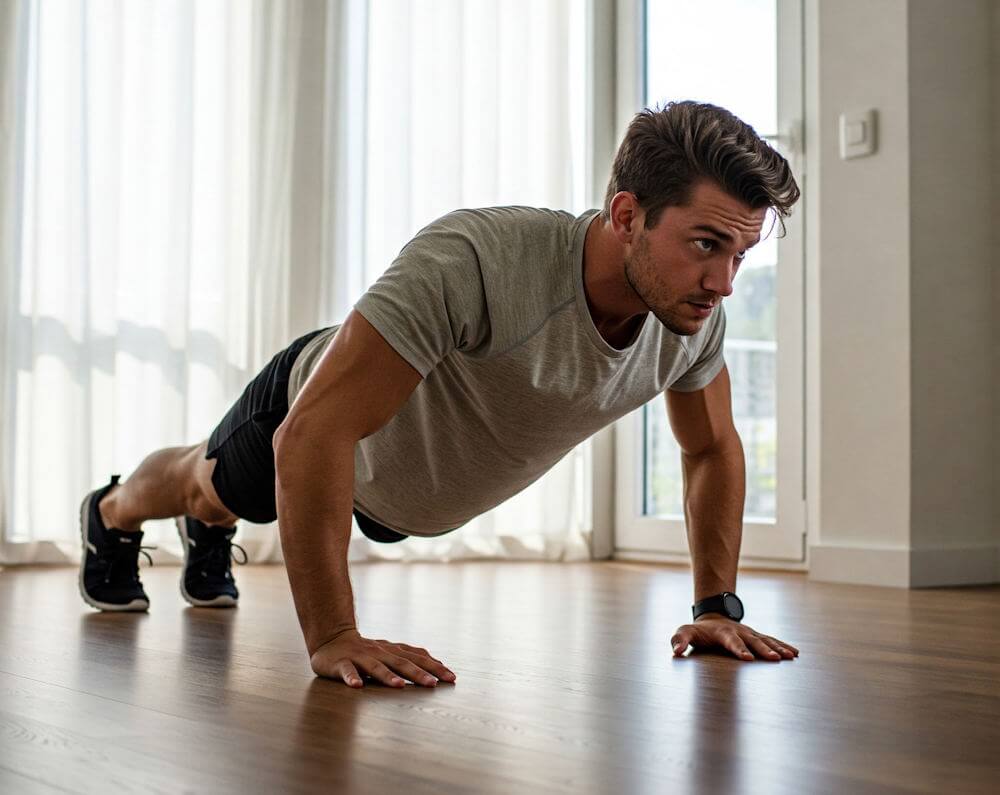Bodyweight exercises are physical exercises that utilize the weight of one’s own body as resistance, requiring no additional equipment. These exercises are effective for building muscle strength and endurance, promoting overall fitness without the need for a gym membership or specialized tools. By engaging multiple muscle groups, bodyweight workouts can be tailored to suit individuals of varying fitness levels, from beginners to advanced athletes.
One significant advantage of bodyweight exercises is their accessibility. Individuals can perform these movements anywhere, making them an appealing option for those who may not have access to gym facilities or prefer to exercise in the comfort of their own homes. This convenience supports consistent workout routines, essential for muscle growth and development. Users can seamlessly integrate these exercises into their daily schedules, whether it’s during a break at work or in the living room at home.
Bodyweight exercises offer various forms of movement, including pushing, pulling, squatting, and core stabilization. This diversity enables individuals to sculpt their bodies strategically by targeting specific muscle groups and ensuring a full-body workout. Moreover, because they hinge on the natural mechanics of the human body, these exercises can help improve balance, coordination, and flexibility while strengthening muscles. The absence of heavy lifting reduces the potential for injury, making bodyweight workouts an excellent choice for individuals who may be new to exercise or those recovering from injury.
As home workouts grow in popularity, bodyweight exercises stand out as a highly effective means to build strength and enhance fitness levels. With determination and consistency, individuals can achieve impressive results through bodyweight workouts, paving the way for enhanced physical health and well-being.
Understanding Muscle Growth
Muscle growth, also known as hypertrophy, is a biological process that involves the enlargement of muscle fibers in response to physical stress. To understand how this phenomenon occurs, it is crucial to examine the mechanisms driven by resistance training. The act of applying force consistently on muscles leads to micro-tears in muscle fibers. During recovery, the body repairs these tiny injuries, resulting in thicker and stronger muscle fibers. This adaptive response is vital for anyone looking to build muscle through bodyweight exercises.
Resistance training serves as the cornerstone of muscle growth, as it directly stimulates the physiological processes involved in hypertrophy. Traditional methods often include weights, but bodyweight exercises, which use an individual’s mass as resistance, can achieve similar outcomes. Exercises such as push-ups, squats, and pull-ups engage multiple muscle groups, effectively challenging them and promoting growth. The versatility of bodyweight exercises makes them an attractive option for those aiming to develop muscle at home.
Moreover, the principle of progressive overload is essential in achieving optimal results in muscle growth. This concept involves gradually increasing the level of stress placed on the muscles. In bodyweight training, this can be accomplished by modifying the difficulty of exercises, increasing repetitions, or decreasing rest intervals. As the muscles adapt to the current challenge, it becomes necessary to progress to more demanding variations to continue promoting hypertrophy. This method not only enhances muscle size but also improves overall strength and endurance, making bodyweight exercises a potent tool in any fitness regimen.
Understanding these foundational concepts equips individuals with the knowledge necessary to effectively design a training program that promotes muscle growth. By integrating bodyweight exercises with a focus on resistance and progressive overload, one can achieve significant muscle development, even in the comfort of their home.
Essential Bodyweight Exercises for Muscle Gain
Bodyweight exercises serve as a highly effective means of building muscle at home. This training method utilizes your body weight as resistance, allowing individuals to enhance strength and muscle tone without the need for specialized equipment. Below are several key bodyweight exercises known to promote muscle growth, including push-ups, squats, pull-ups, and dips.
Push-Ups are a fundamental bodyweight exercise targeting the chest, shoulders, and triceps. To perform a push-up correctly, begin in a plank position with your hands slightly wider than shoulder-width apart. Lower your body until your chest is just above the ground, ensuring your elbows are at a 45-degree angle from your body. Raise yourself back to the starting position. For beginners, knee push-ups can be a suitable modification, while advanced practitioners can try one-arm push-ups.
Squats focus on the major muscle groups of the legs, including the quadriceps, hamstrings, and glutes. To execute a basic squat, stand with your feet shoulder-width apart. Begin the movement by bending your knees and lowering your hips as if you are sitting in a chair, keeping your chest up and back straight. Aim to lower yourself until your thighs are parallel to the ground. Variations, such as jump squats or single-leg squats, can elevate the intensity for advanced users.
Another powerful exercise is the pull-up, which significantly strengthens the back, biceps, and shoulders. Use a sturdy bar and grasp it with an overhand grip. Hang from the bar with arms fully extended, then pull your body upwards until your chin surpasses the bar. This movement can be modified with assisted pull-up bands or by performing inverted rows for those still developing their strength.
Finally, dips are excellent for building muscle in the triceps, chest, and shoulders. To perform dips, find two parallel surfaces or use a sturdy chair. Position your hands on the edge of the surface, legs extended in front of you. Lower your body by bending your elbows until your upper arms are parallel to the ground, then push back up. Beginners may find bench dips easier, while advanced individuals can try straight-bar dips.
Incorporating these essential bodyweight exercises into your routine can effectively facilitate muscle gain, irrespective of your current fitness level. Each exercise can be modified to suit individual capabilities, ensuring progression in strength and fitness.
Creating a Structured Workout Plan
Designing an efficient workout plan is crucial for maximizing the effectiveness of bodyweight exercises, whether one is a beginner or someone with more experience. A well-structured program not only encompasses the frequency, sets, and repetitions for exercises, but also ensures adequate rest and balance across different muscle groups throughout the week.
To establish a frequency that works best, it is generally recommended to engage in bodyweight workouts three to five times per week. This allows for sufficient recovery time between sessions, which is essential for muscle growth and overall performance. The workout plan should incorporate varying intensities, with some days focused on higher intensity exercises and others dedicated to lower intensity recovery sessions or light movement.
When planning the sets and repetitions, a common approach is to aim for 2 to 4 sets of each exercise, with repetitions ranging from 8 to 20, depending on the individual’s fitness level and the specific goals. Beginners may start with fewer sets and reps, gradually increasing as they build strength and endurance. It is essential to listen to one’s body; if fatigue sets in, extending rest periods or decreasing repetitions may be necessary to avoid injury.
Rest periods are another vital component in a structured workout plan. A standard rest interval of 30 to 90 seconds between sets can aid in recovery and maintain workout intensity. Balancing workouts to target various muscle groups is equally important; for example, one might focus on upper body exercises on Mondays, lower body on Wednesdays, and core workouts on Fridays. This strategy ensures that all muscle groups receive attention while enabling recovery periods.
In summary, a well-structured workout plan integrates frequency, sets, repetitions, rest periods, and muscle balance to effectively leverage bodyweight exercises for building muscle at home. By following these guidelines, individuals can develop a routine that is both effective and sustainable, leading to improved strength and fitness over time.
Progressing Your Bodyweight Training
To effectively build muscle through bodyweight training, it is imperative to focus on progression. The principle of progression ensures the continuous challenge of the muscles, leading to growth and adaptation. There are several viable strategies to enhance the difficulty of bodyweight exercises while maintaining proper form.
One of the simplest methods to progress is by increasing repetitions. As your muscles adapt to the current volume, gradually increase the number of repetitions per set. For instance, if you can comfortably perform 10 push-ups, aim for 12 or 15 during subsequent workouts. This method is generally safe and allows continued overload on the muscles, promoting hypertrophy.
Another effective approach involves modifying exercises to elevate their difficulty levels. This can be achieved by altering your body positioning or utilizing various leverage points. For example, transitioning from standard push-ups to decline push-ups or one-legged squats significantly increases the challenge. Also, integrating variations such as Plyometric exercises will not only boost difficulty but also engage different muscle fibers, aiding in overall growth.
Incorporating tempo changes is a sophisticated way to further challenge the muscles. Slowing down the eccentric phase of an exercise, or adding explosive movements, can increase time under tension, which is critical for muscle development. When performing a standard push-up, try lowering your body slowly for a count of three seconds before pushing up explosively. This technique can enhance strength and stability.
Monitoring your progress is crucial in any training regimen. Keeping a workout journal or using fitness apps can help track repetitions, modifications made, and progression over time. This not only helps in observing improvements but also in planning future workouts based on your evolving abilities. By compiling this information, you create a structured approach to bodyweight training, ensuring steady muscle growth and development.
Nutrition for Muscle Growth
Nutrition is a fundamental component in the quest for muscle growth, especially when engaging in bodyweight exercises at home. The right balance of macronutrients—proteins, fats, and carbohydrates—plays a vital role in supporting muscle development and recovery. Each of these macronutrients fulfills specific functions that are crucial for individuals aiming to enhance their muscle mass.
Proteins are the building blocks of muscle tissue, making them essential for muscle repair and growth. When engaging in resistance training or bodyweight exercises, the demand for protein increases as microscopic tears occur in the muscle fibers. Incorporating high-quality protein sources, such as lean meats, poultry, fish, legumes, eggs, and dairy products, can aid in repairing and building muscle tissues. It is generally recommended that individuals aiming for muscle growth consume about 1.6 to 2.2 grams of protein per kilogram of body weight per day.
Fats, often overlooked in discussions about diet for muscle gain, are equally important. They provide essential fatty acids and support hormone production, including testosterone, which plays a crucial role in muscle growth. Foods such as avocados, nuts, seeds, and olive oil can contribute to a balanced intake of fats necessary for overall health and muscle development.
Carbohydrates serve as a primary energy source, especially for those participating in high-intensity workouts. They help replenish glycogen stores, enabling individuals to perform at their best during workouts. Whole grains, fruits, and vegetables should be prioritized as they provide not only energy but also essential vitamins and minerals.
Hydration is another critical aspect of nutrition that cannot be neglected. Proper fluid intake is vital for optimal performance and recovery, as hydration impacts muscle function and overall physical performance. Additionally, meal timing can further enhance results; consuming a protein-rich meal or snack shortly after a workout can significantly impact muscle recovery and growth.
Common Mistakes to Avoid
When embarking on a journey to build muscle at home through bodyweight exercises, it is essential to be aware of common mistakes that can hinder progress. One of the primary errors that beginners often encounter is improper form. Using incorrect techniques not only limits the effectiveness of the exercises but also increases the risk of injury. For instance, during push-ups or squats, failing to maintain a straight back or allowing the knees to collapse can lead to strain and inefficient muscle activation. Therefore, taking the time to learn and practice the correct form is crucial for safety and success.
Another frequent pitfall is neglecting recovery. Many individuals make the mistake of believing that more frequent training will yield quicker results. However, muscle growth occurs during recovery periods, not solely during workouts. Insufficient rest can lead to overtraining, which results in fatigue and diminished performance. It is important to incorporate rest days and ensure that the muscles have adequate time to repair and grow after intense sessions of bodyweight exercises.
Additionally, many beginners fall into the trap of plateauing due to failure to implement progressive overload. Bodyweight exercises offer a significant advantage, as they can be easily adjusted to maintain challenge. However, sticking to the same routine over time can cause muscle growth to stagnate. This can be avoided by gradually increasing the difficulty of exercises—such as performing variations like single-leg squats or explosive push-ups—or by increasing the number of repetitions and sets. By consistently challenging the muscles, progress continues and the risk of hitting a plateau is mitigated.
Incorporating Flexibility and Mobility Work
In the pursuit of building muscle at home, it is essential to incorporate flexibility and mobility exercises into your routine. While bodyweight training primarily focuses on strength, neglecting flexibility can lead to imbalances, reduced range of motion, and increased risk of injury. Therefore, integrating a structured flexibility and mobility program can significantly contribute to overall fitness and recovery.
One effective method to enhance flexibility is through a consistent stretching routine. Incorporating dynamic stretches, such as leg swings or arm circles, before workouts can prepare your muscles for the upcoming strain. Post-workout, static stretching should be prioritized. This involves holding stretches for 15-30 seconds, targeting key muscle groups that were engaged during your workout. For example, after a series of push-ups, consider stretching your chest and shoulder muscles. Regular stretches can improve blood circulation and promote muscle recovery, ensuring that you maintain optimal performance during subsequent training sessions.
In addition to stretching, mobility drills are fundamental to enhancing joint function and coordination. Exercises like deep squats, hip openers, and spinal twists can be incorporated into your warm-up or cooldown routines. These mobility-focused movements improve joint health by promoting synovial fluid production, facilitating smoother movements, and preventing stiffness. A well-rounded mobility routine can also enhance your bodyweight exercises’ effectiveness, as improved flexibility allows for deeper, more controlled movements.
To create an effective flexibility and mobility plan, consider allocating specific days dedicated solely to these exercises or integrating them into your general workout routine. Aim for at least 10-15 minutes of dedicated mobility work before and after bodyweight workouts. Remember that the benefit of these practices extends beyond muscle recovery; they contribute to better posture, greater athletic performance, and an overall enhanced quality of life.
Staying Motivated and Committed
Maintaining motivation and commitment to a bodyweight exercise routine can be challenging, especially when workouts are performed at home. One effective strategy is to set realistic and attainable goals. These objectives can range from mastering specific movements, improving endurance, or increasing the number of repetitions over time. Dividing larger goals into smaller, manageable milestones helps create a sense of accomplishment that can keep motivation levels high.
Tracking your progress is another essential tactic. Keeping a workout journal or using mobile applications designed for fitness tracking can provide visual affirmation of your advancements. Documenting your workouts not only helps identify areas needing improvement but also allows for personal reflection on how far you have come. Regularly revisiting your goals and recognizing incremental achievements can significantly boost your commitment.
Connecting with a community can serve as a driving force for many individuals engaged in bodyweight exercises at home. Whether through online forums, social media groups, or workout apps, finding like-minded individuals who share similar goals can foster accountability and encouragement. Participating in group challenges or virtual classes can make exercise feel less isolating and more enjoyable, thus amplifying your dedication to the routine.
Lastly, celebrating milestones is crucial for reinforcing your commitment. Whether it’s recognizing a month of consistent workouts or mastering a difficult exercise, taking the time to acknowledge these achievements can enhance motivation. Rewards, whether they are small treats or new fitness gear, can help maintain a positive relationship with your routines.
Ultimately, a combination of setting clear goals, tracking progress, finding support, and celebrating successes creates a solid framework for staying motivated and committed to your bodyweight exercises at home. Consistency in these practices can lead to enduring results, both physically and mentally.




